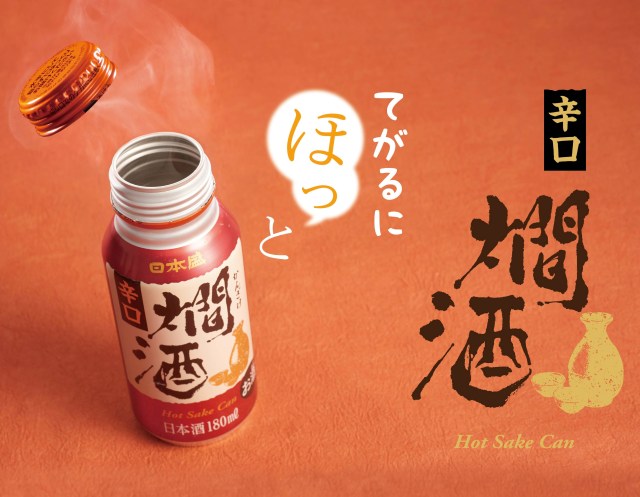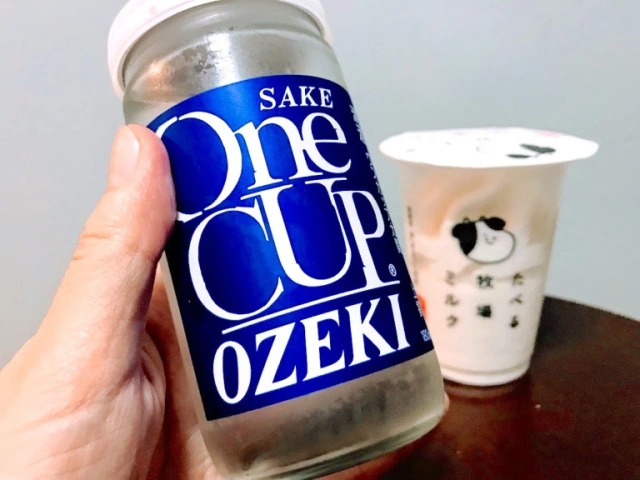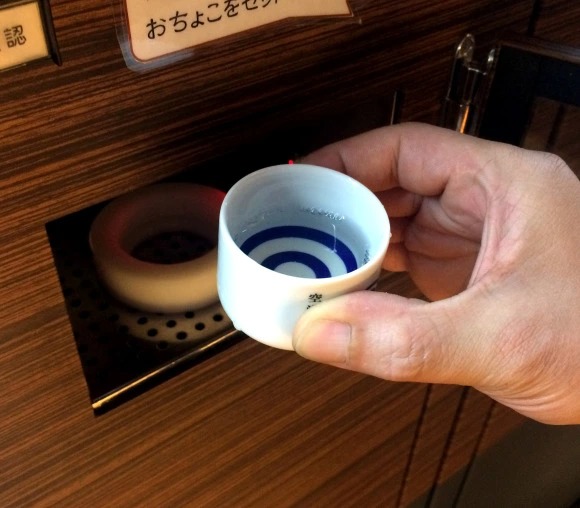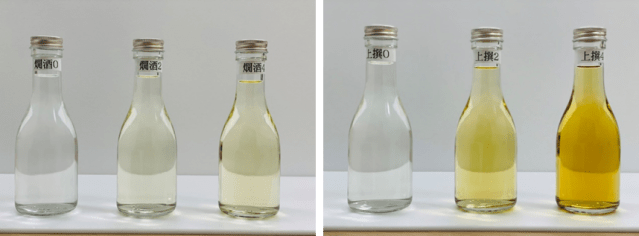
Some like it hot, but can’t find it easily.
One of the great things about nihonshu, more commonly known as “sake” in English, is its ability to be enjoyed at a wide range of temperatures, from chilled to piping hot. As such, anyone who takes a trip to most convenience stores in Japan will have no problem getting cold and room temperature bottles, cans, or even drinking boxes of sake.
▼ Perfect for those boozy ice cream cravings

Hot sake, often served at a temperature of around 50 degrees Celsius (122 degrees Fahrenheit), however, is a far rarer thing in stores. In order to enjoy it, people would usually need to heat it themselves either at home or using a convenience store’s microwave or hot water, which is less than ideal since they’d need to drink it right away. This situation is not for a lack of demand, but has more to do with the inherent properties of this unique beverage.
Sake often prides itself on being a very natural product, produced solely from water, rice, and bacteria such as yeast. Anything else added to it is considered impure in more ways than just a matter of pride. If more than even the slightest amount of additives are included, the government will refuse to classify it as “nihonshu,” labeling it as an ordinary “liqueur” instead under the national liquor tax laws.
▼ On the other hand, adding sake to things, such as instant ramen, is permitted

Pasteurization — the act of heating to kill off bacteria — is the most common way to prolong its life without adding any preservatives, but even then the remaining active contents of sake are still highly susceptible to both heat and light.
In the case of heat, an effect called the Maillard reaction occurs in sake. This is a very common chemical reaction of amino acids and sugars when heat is applied to many foods, causing them to turn brown. It’s an effect than can be seen in baking bread or frying up potatoes, and anyone who has smelled either can probably agree that the Maillard reaction kicks ass.
Even in sake, the Maillard reaction can produce pleasant results, and some aged sake producers make use of it in their more complex flavor profiles. Most standard sake brands, however, put a lot of stock in their own distinctly fine-tuned flavors, and the Maillard reaction would only serve to corrupt it. A crystal clear appearance is also considered a mark of quality in most types of sake, so browning would be frowned upon.
▼ Sake cups often have blue circles in the bottom as a way to more easily inspect the sake’s clarity

To make matters worse, when exposed to prolonged high temperatures, sake also begins to emit a certain odor that the industry refers to as hineka or “old smell” that can probably be best described in English as “stale” (as the word is used with aromas). All sake develops this smell given enough time, but heat accelerates its production.
So if a sake brewery wanted to sell hot sake in vending machines or convenience stores it would have to replenish its stock on a near daily-basis before it tuned into a brown, stale-smelling brew. The impracticality of this led Nihonsakari, a brewery in Hyogo Prefecture’s famous Nada region of sake producers, to research an alternative and as a result came up with Kanzake Bottle. This slightly dry sake is sold in 180-milliliter (six-ounce) heat-insulating cans that can now be stored for weeks in high-temperature conditions.
▼ Kanzake Bottle
When kept under a constant temperature of over 60 degrees Celsius (140 degrees Fahrenheit) for about a month, Kanzake Bottle showed considerably less browning than a regular sake had after only two weeks.
▼ Left: Kanzake Bottle – new, after two weeks, after four weeks / Right: regular sake – new, after two weeks, after four weeks
This level of preservation was very difficult to accomplish while keeping Kanzake Bottle a true “sake” without any additives. Using trial and error, Nihonsakari had to find the right balance of amino acid and sugar content to both inhibit the Maillard and preserve the taste. They also needed to curb the hineka smell by finding a yeast, among 20,000 varieties, that was least likely to produce it.
▼ The blue line shows the increase of hineka (y-axis) over weeks (x-axis) in 60-degree temperature. The red line shows the lack of increase in Kanzake Bottle
In addition to making hot sake retail a lot more convenient in Japan, this new method of brewing sake can even help make it more accessible to people living in hotter climates. Unlike other sake, Kanzake Bottle can be safely exported to and stored in scorching summer conditions without a need for refrigeration, thus spreading the joy of sake to all corners of the world. However, first it must be approved by drinkers in Japan as enjoyable after undergoing these tricky alterations, and sell well.
If it does it’ll be fantastic news for both fans of hot sake and hot fans of sake.
Source: PR Times
Images: PR Times (unless otherwise noted)
● Want to hear about SoraNews24’s latest articles as soon as they’re published? Follow us on Facebook and Twitter!




 Heat sake like they do at a Japanese izakaya with this special at-home set
Heat sake like they do at a Japanese izakaya with this special at-home set Drinking sake just got more convenient with convenience store Family Mart’s new canned brews
Drinking sake just got more convenient with convenience store Family Mart’s new canned brews Convenience stores’ room-temperature drinks get warm reception on hot days
Convenience stores’ room-temperature drinks get warm reception on hot days Bottled hot water selling like bottled hot cakes in Japan
Bottled hot water selling like bottled hot cakes in Japan You’re not supposed to drink this special sake from Japan【Non taste-test】
You’re not supposed to drink this special sake from Japan【Non taste-test】 The Purple Lucky Bag from Village Vanguard is an extra-large waste of money
The Purple Lucky Bag from Village Vanguard is an extra-large waste of money Private booths are coming to Japan’s Shinkansen bullet trains even sooner than we’d thought【Video】
Private booths are coming to Japan’s Shinkansen bullet trains even sooner than we’d thought【Video】 Things get heavy with the Gold Lucky Bag from Village Vanguard
Things get heavy with the Gold Lucky Bag from Village Vanguard Starbucks Japan ready to get Year of the Horse started with adorable drinkware and plushies【Pics】
Starbucks Japan ready to get Year of the Horse started with adorable drinkware and plushies【Pics】 Collect ’em all! New Pokéfuta accessories now available at Village Vanguard
Collect ’em all! New Pokéfuta accessories now available at Village Vanguard The complete guide to sushi in one handy picture
The complete guide to sushi in one handy picture Starbucks Japan unveils New Year’s drinkware range for 2021
Starbucks Japan unveils New Year’s drinkware range for 2021 Burger King Japan’s crazy patty-only menu item: Depressing, delicious, or both?【Taste test】
Burger King Japan’s crazy patty-only menu item: Depressing, delicious, or both?【Taste test】 Four Shinto shrines to pray for love at in Japan to start the New Year
Four Shinto shrines to pray for love at in Japan to start the New Year Is it rude to sing along at concerts in Japan? We ask a pro musician for his take
Is it rude to sing along at concerts in Japan? We ask a pro musician for his take Japanese beef bowl chain Sukiya’s 2026 Smile Box lucky bag basically pays for itself
Japanese beef bowl chain Sukiya’s 2026 Smile Box lucky bag basically pays for itself Hayao Miyazaki says Happy New Year to Studio Ghibli fans with new art for Year of the Horse
Hayao Miyazaki says Happy New Year to Studio Ghibli fans with new art for Year of the Horse Cup Noodle tries an authentic Jiro-style ramen, but something’s not quite right
Cup Noodle tries an authentic Jiro-style ramen, but something’s not quite right The best Starbucks Japan Frappuccinos we want to drink again in 2026
The best Starbucks Japan Frappuccinos we want to drink again in 2026 We revisited Sweets Paradise after a decade to see if Japan’s dessert buffet still delivers
We revisited Sweets Paradise after a decade to see if Japan’s dessert buffet still delivers That time Seiji called JASRAC to ask why he didn’t get paid royalties for his song being on TV
That time Seiji called JASRAC to ask why he didn’t get paid royalties for his song being on TV We found possibly the quietest Japanese-style hotel in Tokyo’s bustling Shinjuku district
We found possibly the quietest Japanese-style hotel in Tokyo’s bustling Shinjuku district Pizza Hut Japan’s hot lucky bags are perfect for a New Year’s pizza party
Pizza Hut Japan’s hot lucky bags are perfect for a New Year’s pizza party Japan’s oldest largetooth sawfish in captivity back on display in Mie Prefecture
Japan’s oldest largetooth sawfish in captivity back on display in Mie Prefecture 7-Eleven Japan starts new temporary luggage storage service in over 300 branches
7-Eleven Japan starts new temporary luggage storage service in over 300 branches Disillusionment at Tsukiji’s tourist-target prices led us to a great ramen restaurant in Tokyo
Disillusionment at Tsukiji’s tourist-target prices led us to a great ramen restaurant in Tokyo Starbucks teams up with 166-year-old Kyoto doll maker for Year of the Horse decorations【Photos】
Starbucks teams up with 166-year-old Kyoto doll maker for Year of the Horse decorations【Photos】 Tokyo considering law requiring more trash cans following litter increase in heavily touristed area
Tokyo considering law requiring more trash cans following litter increase in heavily touristed area Tokyo’s Tsukiji sushi neighborhood asks tour groups to stay away for the rest of the month
Tokyo’s Tsukiji sushi neighborhood asks tour groups to stay away for the rest of the month Tokyo event lets you travel back in time, for free, to celebrate 100 years since Showa era start
Tokyo event lets you travel back in time, for free, to celebrate 100 years since Showa era start Japan may add Japanese language proficiency, lifestyle classes to permanent foreign resident requirements
Japan may add Japanese language proficiency, lifestyle classes to permanent foreign resident requirements Sanrio theme park in Japan announces plans to expand into a Sanrio resort
Sanrio theme park in Japan announces plans to expand into a Sanrio resort Stamina-destroying “Paralysis Noodles” are Tokyo’s newest over-the-top ramen innovation
Stamina-destroying “Paralysis Noodles” are Tokyo’s newest over-the-top ramen innovation Survey asks foreign tourists what bothered them in Japan, more than half gave same answer
Survey asks foreign tourists what bothered them in Japan, more than half gave same answer Japan’s human washing machines will go on sale to general public, demos to be held in Tokyo
Japan’s human washing machines will go on sale to general public, demos to be held in Tokyo Japan’s deadliest food claims more victims, but why do people keep eating it for New Year’s?
Japan’s deadliest food claims more victims, but why do people keep eating it for New Year’s? We deeply regret going into this tunnel on our walk in the mountains of Japan
We deeply regret going into this tunnel on our walk in the mountains of Japan Studio Ghibli releases Kodama forest spirits from Princess Mononoke to light up your home
Studio Ghibli releases Kodama forest spirits from Princess Mononoke to light up your home Major Japanese hotel chain says reservations via overseas booking sites may not be valid
Major Japanese hotel chain says reservations via overseas booking sites may not be valid Put sesame oil in your coffee? Japanese maker says it’s the best way to start your day【Taste test】
Put sesame oil in your coffee? Japanese maker says it’s the best way to start your day【Taste test】 No more using real katana for tourism activities, Japan’s National Police Agency says
No more using real katana for tourism activities, Japan’s National Police Agency says Starbucks Japan reveals new sakura drinkware collection, inspired by evening cherry blossoms
Starbucks Japan reveals new sakura drinkware collection, inspired by evening cherry blossoms Updated cherry blossom forecast shows extra-long sakura season for Japan this year
Updated cherry blossom forecast shows extra-long sakura season for Japan this year Asahi now sells hot bottled water in Japan as an alternative to coffee or tea
Asahi now sells hot bottled water in Japan as an alternative to coffee or tea Stray dogs head to convenience stores in Thailand, receive free rabies shots and flea care
Stray dogs head to convenience stores in Thailand, receive free rabies shots and flea care 7-Eleven Japan’s frozen hot biscuits are so good, they might make pancakes obsolete!
7-Eleven Japan’s frozen hot biscuits are so good, they might make pancakes obsolete! We get some outside help making a pro drinking meal from 7-Eleven【Japan’s Best Home Senbero】
We get some outside help making a pro drinking meal from 7-Eleven【Japan’s Best Home Senbero】
Leave a Reply